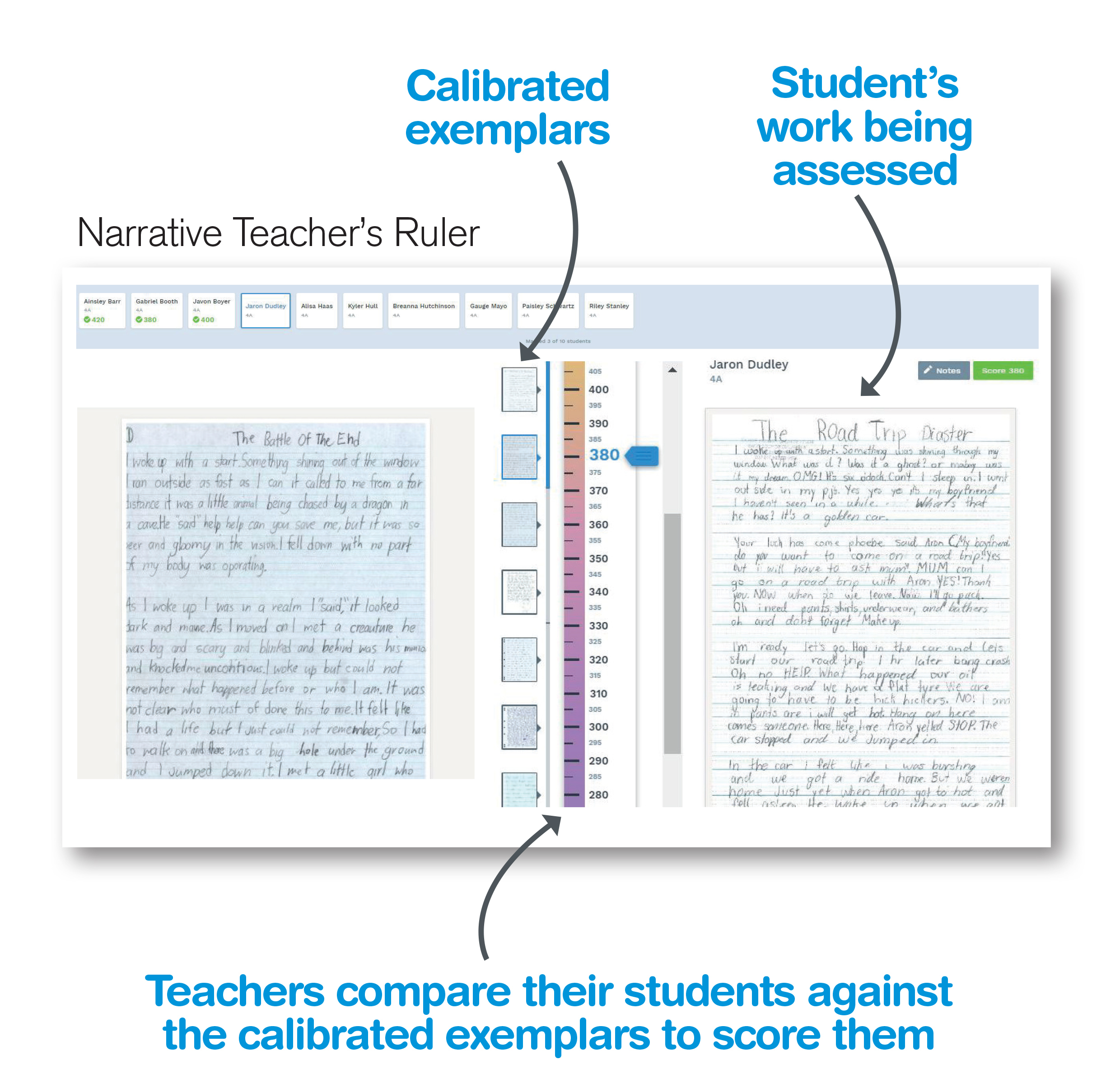Brightpath Progress is a result of a decade of pioneering research at The University of Western Australia supported by grants from the Australian Research Council.
It is based on a two-stage method of assessment.
Stage 1 involves using pairwise comparisons to construct a scale by calibrating exemplars (student writing samples) of student performances on an open-ended assessment task. Sets of exemplars are then selected as anchor points on a scale, which is referred to as the Teacher’s Ruler.

Stage 2 includes making assessments by judging where performances sit on the scale constructed in stage one. Teachers assess their students’ work by judging which of the calibrated performance a student’s work is most alike.
Developing an assessment tool for ‘difficult to assess’ areas
Since 2014, Brightpath has been proven to be the leading formative assessment tool in Australian education.
In 2018 and 2019, an evaluation by an independent organisation showed that students in schools who used Brightpath frequently achieved a significantly greater improvement in NAPLAN Writing results, compared to students in schools who did not use the program.
Over 20,000 educators in over 1000 schools across Australia are now using Brightpath, with more than two million assessments made within the platform.
Learn more about our research impact at the University of Western Australia here.
Brightpath Formative Assessment Research Papers
Summary: This study investigates the extent to which the use of a two-stage method of assessment involving calibrated exemplars provides judgements from teachers that are consistent.
Assessment of early writing was chosen as a context to investigate the method as it is fundamental to students’ progress in schooling.
The findings: The two-staged process showed a level of consistency in teacher judgement-making. In addition, judgements made by experienced markers with the calibrated exemplars with judgements made using the criterion-based rubric.
Summary: This paper outlines how teachers judge writing scripts using the process of pairwise comparison to generate a scale and discusses the benefits of using the method to supplement and validate results from large-scale testing programs.
The findings: The analysis showed high internal consistency of the teacher judgements. The scale locations from pairwise comparisons were highly correlated with scale estimates for the same students from a large-scale testing program.
Summary: This paper explores standard ‘grid-like’ rubrics used to assess students’ writing in a large-scale testing program and presents empirical evidence for the existence of a potentially widespread threat to the validity of rubric assessments that arose due to design features.
The findings: The research questions whether rubrics with structurally aligned categories can validly assess complex skills. A solution is proposed that involves rethinking the structural design of the rubric to mitigate the threat to validity, where broader implications are also discussed.
Summary: This paper studies a two-stage method using comparative judgments and calibrated exemplars as a complement and alternative to existing methods of assessing writing. Written performances were taken from Australia’s NAPLAN assessment, which included both narrative and persuasive performances from students aged 8 to 15.
The findings: The comparative judgments performed in Stage 1 showed a high level of reliability and concurrent validity. These matching judgments in Stage 2 also showed a high level of reliability and concurrent validity. Overall, the findings support the use of the method in standardised writing assessment and its application to various learning areas.
Summary: This study explores the perceived relevance of assessment criteria in differentiating writing performance levels. Experienced writing assessors were asked to directly compare pairs of performances, determine which performance was better and record which aspects of writing were used to make those determinations.
The findings: The assessors perceived certain criteria relevant more often than others. In particular, the conventions of writing, such as punctuation and spelling, were perceived relevant less often than authorial aspects. These findings have potential implications for selecting which criteria to use in narrative writing rubrics and they suggest advantages of granting assessors discretion in their selection and application of criteria.
Summary: This article looks at the reliability of a two-stage method used by classroom teachers to assess primary school students’ persuasive writing.
The findings: A high level of interrater reliability among teachers was obtained. This is consistent with previous evidence that the two-stage method is a viable classroom assessment method without extensive training and moderation.
Summary: The aim of this study is to develop an approach that enables teachers to assess oral language in a reliable, valid and comparable manner and to support targeted teaching of oral language.
The findings: The findings indicate that the two-stage assessment provides a valid and reliable way for classroom teachers to assess oral language of students aged approximately four to nine years. The assessment also provides teachers with information about students’ oral story-telling ability along with information about the skills that students need to learn next.
Summary: This paper reviews the level of reliability of assessments made by primary school classroom teachers of narrative writing using a two-stage classroom assessment method.
The findings: The results show high levels of inter-rater reliability among teachers. The findings reproduce and expand on previous evidence indicating the two-stage method is a viable method of classroom teacher assessment of written performances.
How does Brightpath’s formative assessments help teachers and schools?
Brightpath supports teachers by using brief descriptors and annotations in conjunction with the exemplars. This makes the teacher’s job become more efficient. When assessing students’ work, they simply determine where their students fit on the scale. It also provides highly reliable teacher judgements of student achievement.
See proof of the difference you make!
Get started using Brightpath Progress in your school. Book a demo today!